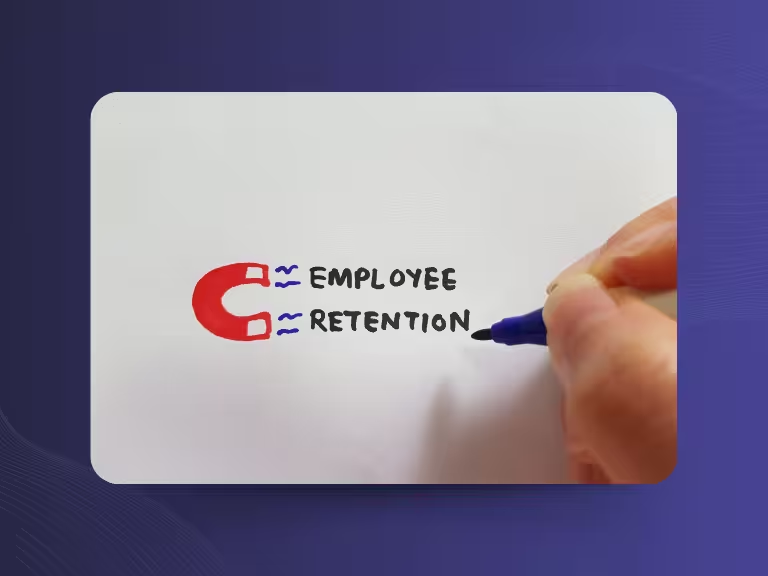Table of Contents
Why Employee Retention is Critical Today
In an era where skilled workers are scarce and job changes have become the norm, employee retention has become one of the most important tasks for companies. But what does this actually mean exactly? Employee retention describes all measures and strategies aimed at keeping qualified employees in the company long-term and strengthening their loyalty.
The numbers speak clearly: The costs of filling a position can amount to up to 150% of the position's annual salary. Add to this the loss of knowledge, disrupted workflows, and a strained workplace climate. At the same time, companies are competing for the best talent in an increasingly competitive job market.
This article shows you concrete strategies and current trends that can help you retain your employees long-term. You'll learn which measures really work and how to successfully implement them in your company.
What is Employee Retention? Definition, Meaning and Levels
Definition and Basic Understanding
Employee retention is more than just an HR buzzword. It's a strategic business task aimed at increasing the tenure of qualified employees and strengthening their emotional connection to the company.
It's important to distinguish it from related concepts: While employee satisfaction describes how comfortable employees feel in their job, employee retention goes one step further. It aims to ensure that employees not only are satisfied but also want to remain with the company long-term. Employer branding, on the other hand, focuses on external perception as an attractive employer.
The Four Levels of Employee Retention
Effective employee retention works on different levels that reinforce each other:
Rational binding is based on tangible benefits such as good salary, secure jobs, or attractive benefits. This binding is important but often not sufficient, as it can easily be outbid by competitors.
Emotional binding emerges through trust, appreciation, and identification with the company. Employees feel like part of a team and share the company values. This binding is particularly strong and sustainable.
Normative binding is based on a sense of obligation toward the company. Employees stay because they feel loyal or have the feeling they owe something to the company - perhaps after training or special support.
Behavioral binding manifests in actual behavior: Employees engage beyond the minimum requirement, recommend the company to others, and remain loyal even in difficult times.
Importance for Companies
Strong employee retention directly impacts business success. Studies show that companies with highly engaged employees are 21% more profitable than those with less engaged teams. At the same time, turnover is drastically reduced, which not only saves costs but also ensures stability and continuity in business operations.

Effective Measures to Increase Employee Retention
Establishing a Feedback and Appreciation Culture
One of the most effective measures for employee retention is establishing an open feedback culture. Regular, constructive feedback shows employees that their work is valued and where they can develop further.
This isn't just about the annual employee review. Continuous feedback in daily work, spontaneous recognition for good performance, and the opportunity to contribute their own ideas create an environment where employees feel valued. Tools like Sally can help document important conversations and ensure that agreed-upon development goals are not forgotten.
Training, Career Development and Personal Support
Employees only stay long-term where they can develop further. Companies should therefore invest in professional and personal development and show clear career paths.
This can range from external training to internal mentoring programs to job rotation. Transparency is particularly important here: Employees must know what development opportunities exist and how they can achieve them.
Flexible Work Models and Work-Life Balance
The pandemic has shown how important flexible work models are. Home office, flexible hours, and part-time options are no longer nice-to-have but must-have for many employees today.
Additionally, measures for health promotion and stress prevention are gaining importance. Whether company sports, health checks, or mental health support - such offerings show that the company takes its employees' well-being seriously.
Participatory Corporate Culture and Employee Involvement
People want to contribute and have influence. Companies that actively involve their employees in decision-making processes create a strong sense of belonging and responsibility.
This can happen through regular employee surveys, idea management systems, or participation in strategic projects. It's important that the participation is not just symbolic but actually influences decisions.
Fair and Transparent Compensation
Even though money isn't everything, fair compensation remains an important building block of employee retention. This involves not just the base salary but also benefits like company pension plans, company cars, or flexible working time models.
Transparency in the compensation structure creates trust and prevents dissatisfaction. Employees should understand how their pay is determined and what opportunities exist for salary increases.
Digital Support Through Modern HR Technologies
Modern HR software can help systematically improve employee retention. Tools for performance evaluation, feedback platforms, and systems for analyzing turnover risks provide HR professionals with valuable insights.
AI-supported systems can even suggest individual career paths and provide early warning when employees become dissatisfied. Meeting assistants like Sally can also contribute by documenting important conversations with employees and thus enabling better follow-up of agreements.

The Benefits of Strong Employee Retention for Companies
Productivity Increases and Quality Improvements
Employees who feel connected to their company work not only more motivated but also more productively. They identify with company goals and commit to achieving them. This leads to higher quality work and more innovation.
Long-term employees know the processes better, have more experience, and can work more efficiently. They also function as knowledge repositories for the company and can guide younger colleagues.
Reduction of Absences and Turnover
Strong employee retention leads to fewer sick days and significantly lower turnover. This not only saves the direct costs of recruitment and onboarding but also ensures a more stable workplace climate.
Teams that work together over longer periods develop better workflows and stronger trust among each other. This has a positive effect on the entire work atmosphere.
Strengthening Employer Brand (Employer Branding)
Satisfied, long-term employees are the best ambassadors for a company. They recommend their employer and contribute to a positive reputation. This makes it easier to attract new talent and reduces recruiting costs.
In times of rating platforms like Kununu, poor employee retention can quickly become a reputation problem. Conversely, positive employee reviews can be a real competitive advantage.
Sustainable Employee Retention: Strategies for the Future
Developing Long-term Retention Concepts
Successful employee retention goes beyond short-term measures. It requires a well-thought-out, long-term concept that is embedded in the company strategy.
Company values play a central role here. Employees want to work for a company whose values they share. A clear vision and lived corporate culture create the foundation for sustainable retention.
Considering Cultural Differences and International Perspectives
In internationally operating companies, retention strategies must be adapted to cultural particularities. What works in Germany may not be successful in other cultures.
While work-life balance and security are important in Germany, career opportunities or team belonging may be in the foreground in other cultures. Successful international employee retention therefore requires cultural sensitivity and local adaptations.
Practical Examples and Best Practices
Companies like Google rely on exceptional benefits and an innovation-friendly culture. Employees have 20% of their work time available for their own projects, which leads to more engagement and creativity.
SAP e.g. invests heavily in employee training and offers clear career paths. The company has recognized that in the fast-paced IT industry, continuous education is crucial for employee retention.
Volkswagen focuses on a strong workplace community and long-term perspectives. The company offers its employees security and stability, which is particularly valued in uncertain times.

Employee Retention in the Digital Age: Opportunities Through Modern Tools
Digitalization opens new possibilities for employee retention. Automated feedback systems can conduct regular pulse surveys and help recognize team moods early.
GDPR-compliant meeting assistants like Sally can document and analyze employee conversations without violating privacy. This allows HR professionals to make better decisions and better understand individual needs.
Modern communication tools improve internal collaboration and create transparency. Employees feel better informed and more involved, which directly contributes to retention.
Conclusion: Action Recommendations for Sustainable Employee Retention
Successful employee retention is not a coincidence but the result of a well-thought-out strategy. The most important success factors are an open feedback culture, continuous training, flexible work models, and active employee involvement in decision-making processes.
It's particularly important to consider all four levels of retention: rational, emotional, normative, and behavioral aspects. Only a holistic approach leads to sustainable results.
Modern technologies can provide support but should never replace human attention and appreciation. The combination of personal care and digital support is the key to success.
Companies that invest in employee retention today secure not only qualified employees but also a decisive competitive advantage. In times when talent is scarce, they cannot afford to lose good employees.

Try meeting transcription now!
Experience how effortless meeting notes can be – try Sally free for 4 weeks.
Test NowOr: Arrange a Demo Appointment

.avif)


